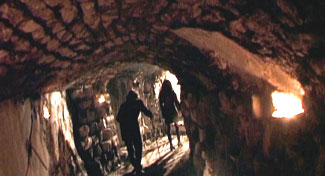 The Italian horror short Pickman's Model (2007) was included in the "extras" of the H. P. Lovecraft Collection Volume 4 (2007).
The Italian horror short Pickman's Model (2007) was included in the "extras" of the H. P. Lovecraft Collection Volume 4 (2007).
The "main" feature was supposed to be the forty-four minute Chilean adaptation of the same Lovecraft story, vis, Chilean Gothic: Pickman's Model (2000).
That "main" film is only so-so, but the shorter Italian take by Giovanni Furore is quite good, indeed the best thing on the whole disc. It is dark & moody with a real theatrical-release feel to it, rather than the amateur-video feel of much of the multi-volume dvd collection.
Substantial in texture even though under a half hour in length, the director is at the very start of a filmmaking career, but has considerable expertise even so. He has worked in Rome as an editor of video & 35 mm film for cinematic & television productions, so he has more technical skill than a first-time director can generally boast.
It has a limited, mostly effective cast except possibly for Pickman himself. Lorenzo Mori plays the stooped madman like a cartoon character, & he can't even limp without looking phony. This one weak factor aside, the film is rather stunning. Moody dark photography of evocative narrow streets & alleys, antique architecture, doomful interiors & tunnels -- it's all deliciously creepy & beautiful.
A woman (Eva Chiorazzo) follows the mysterious, limping Pickman into dim, torchlit catacombs -- a splendid location for this tale. "Do I undress myself?" she asks, as she's a professional model, & Pickman is an eccentric artist. "No," he says. "That is not my thing." He bings photographing her with the antique equipment in his subterranean room.
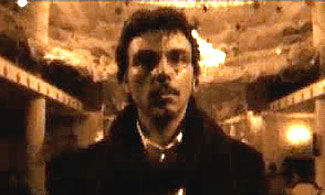 He then leaves the stone-walled studio, locking her underground. Her demise, at the hands of what unknown creature, occurs off screen, reliant as it is on mood rather than gore. He then leaves the stone-walled studio, locking her underground. Her demise, at the hands of what unknown creature, occurs off screen, reliant as it is on mood rather than gore.
Elsewhere, & evidently much later, Russell (Alessandro Di Lorenzo) gets a phone call. A friend insists on seeing him.
Soon Howard Marsh (Vittorio De Stefano) arrives at Russell's richly appointed rooms, insisting upon returning a painting that has been driving him insane, a painting by the notorious Pickman.
Marsh then tells his story in flashback, of how a frightening mystical response he felt during a public viewing of Goya's famously dark painting "Saturn Eating His Children" brought him into the company of Pickman, who for the first time desired to reveal to someone the secret of his own horrific art, such as went far beyond mere imagination, reveal it to someone with sufficient sensitivity to fully grasp the larger meanings.
Though the performance of Pickman is mere caricature, Marsh is played to nervous perfection. The old world architecture through which these characters move would've delighted HPL himself. Like HPL, the director has chosen atmosphere & environment to bring off the effect of horror.
Marsh is brought to Pickman's gloomy lair deep in the catacombs & shown the chasm that connects to a far older world. Here too are Pickman's canvasses, their pure horror inducing further visionary responses like Marsh had had to the Goya painting. And Pickman asserts that he paints only what is real, what he has seen.
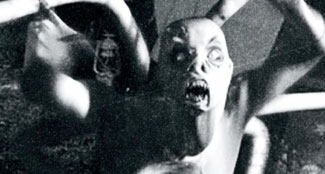 After Pickman forcibly removed Marsh from the underground studio, he listens through a door. Sound alone conveys the final terrible fate of Pickman. After Pickman forcibly removed Marsh from the underground studio, he listens through a door. Sound alone conveys the final terrible fate of Pickman.
This is the hokiest part of the film, but as in HPL's story itself Marsh never actually sees the creature head-on, but knows of it only indirectly. Except he knows certainly that that certain painting was of something all too real, for he has seen the photograph Pickman took in preparation for the great work. We, the viewers, get to see that photograph too.
Most versions of "Pickman's Model" fall to pieces over the artwork, & this Italian take on the tale has been careful not to show much in the way of artworks, leaving it to imagination. But we do see the photograph, & here the film's mild but sure genius is cinched, for it is a creepy revelation.
No other version, as reviewed below, comes anywhere near capturing the mood, tone, & trauma of the unseen; but this film moves slowly, inexhorably, subtly & intelligently toward the final scene, with complete revelation. The result is a superior homage to a great writer.
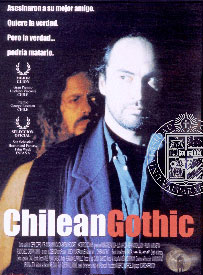 Gabriel Martinez (Rodrigo Sepulveda) has lost a friend Aǹbal (Gilberto Villarroel) under horrific circumstances. He secretly belives the responsible culprit is Richard Upton Pickman (Renzo Oviedo), an eccentric artist of occult subjects. Under cover of his actual profession as journalist, he undertakes to locate the missing artist.
Gabriel Martinez (Rodrigo Sepulveda) has lost a friend Aǹbal (Gilberto Villarroel) under horrific circumstances. He secretly belives the responsible culprit is Richard Upton Pickman (Renzo Oviedo), an eccentric artist of occult subjects. Under cover of his actual profession as journalist, he undertakes to locate the missing artist.
In adapting Lovecraft's tale of the New England artist to the Chilean setting, Chilean Gothic (issued in the H. P. Lovecraft Collection as Pickman's Model, 2000), it is asserted that Pickman moved from America to Chile to research & paint mythological beings indiginous to that country, where he was at first embraced for his macabre genius, but all too soon outcase from the arts community.
There's no effort to make Pickman seem at all acquainted with America, however, nor any effort to convey noticibly indiginous content or context. So it was a feeble revision & the script just should've assumed a Chilean setting for Pickman's endeavors without such muddy excuses.
Before the film was made, sreenwriter Gilberto Villarroel entered his script into a contest, & won. The prize for which was enough 16 mm film stock to make a shortish film. He & his friend, director Ricardo Harrington, set out with great enthusiasm to cast the film. Their achievement was to become a minor cause celebre in Lovecraft fandom, for presumedly remaining true to Lovecraft's vision, though I'd say that's the case only in comparison to the abysmal adaptations too often encountered.
In Spanish with English subtitles, the first half of the film is not at all bad, & has a periodically "film noir jazz" score I quite liked. The film is mostly credibly acted. The story is most mysterious & interesting before Pickman becomes the major on-screen figure.
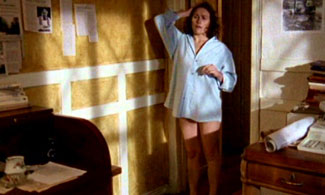 Which is to say, the search for the man is more interesting than finding him, as Renzo Oviedo is not the best actor in the cast & his melodramatic line delivery gives it the tone of a second-rate Mexican horror tale of the 1950s, not really capturing the decadence & obsession of a mad aesthete. Which is to say, the search for the man is more interesting than finding him, as Renzo Oviedo is not the best actor in the cast & his melodramatic line delivery gives it the tone of a second-rate Mexican horror tale of the 1950s, not really capturing the decadence & obsession of a mad aesthete.
Gloomy dark cinematography sustains the mood as our investigative journalist & would-be avenger declines in mental health even before finding the horrific answers to the mystery of the realism of Pickman's demonic portraits.
Though Gabriel is well enough played, the talky script does try one's patience for too long, & there are a couple corny patches of jabber between Gabriel & Pickman that loose the flow entirely with a combination of trite & overweening. Gabriel has found Pickman upon the myth-haunted isle of Chloe off the coast of Chile, where artist had been living in the absurdly named Gordon Pym Hotel.
The hotel's name is a Poe reference too cornpone for words, again tossing the reader out of the story to ponder the unintended comedic results of so much well-intended but purely fannish revision
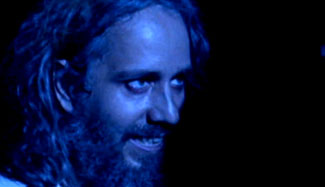 Perhaps it was meant to imply that the "well" around which Pickman has built is subterranean art studio is as Poe's Gordon Pym discovered "black as the pit from Pole to Pole." Perhaps it was meant to imply that the "well" around which Pickman has built is subterranean art studio is as Poe's Gordon Pym discovered "black as the pit from Pole to Pole."
But Lovecraftian posturing is already too dangerously close to parodying Poe for such reminders to be anything but harmful to sustaining a given tale's reality.
He & Pickman wander shadowy caverns beneath the hotel, but with nothing at all happening; the film could've been a good fifteen minutes shorter to its benefit. The demon of the chasm is eager to escape the lidded hole. And at the moment when vengeance is in hand, Gabriel's pistol leveled at vastly over-acted Pickman, he realizes the truth is more compelling than revenge.
He turns away from his planned act of murder & demands, instead, to be shown the horror that dwells in the pit, for a final revelation that so much hinges on for Chilean Gothic to genuinely pay off well. And alas, it pretty much fails to impress.
So for all that is good especially in the first half of the film, it becomes plodding & jabbery as it progresses, & ends unsuccessfully. But among the growing canon of Lovecraft adaptations -- so many of which having been so very, very bad -- this one is by comparison a considerabloe improvement.
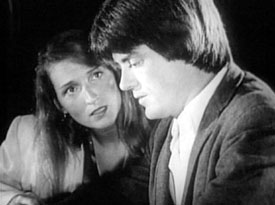 A student thesis version of Pickman's Model (1981) is in black & white, directed by Austin's Cathy Welch. A big part of my psyche wants women to be better than guys when they make a Lovecraftian film, as women are a distinct minority in horror direction, & should bring something a little different & perhaps better.
A student thesis version of Pickman's Model (1981) is in black & white, directed by Austin's Cathy Welch. A big part of my psyche wants women to be better than guys when they make a Lovecraftian film, as women are a distinct minority in horror direction, & should bring something a little different & perhaps better.
Alas, this is a bad film, entertaining only on the level of "amateur fun." The b/w cinematography wouldn't've been too bad but the sets, the script, & most especially the acting, are just so terrible. If there'd been just a half-thimble of talent involved it might've come off like a '60s Roger Corman film.
There's certainly no wonder that the director, armed with worthless arts degree, never again to did become a filmmaker even though fresh out of school she moved to Hollywood for a while & tried. In a classic case of "those who can't do, teach," she settled for film courses at Austin Community College & the Austin Film School. In my nightmares, this is where my life as an artist took me!
Imagine dreaming of having a class with Jim Jarmusch & ending up with Cathy Welch, who is to this day bragging she got to be one of the assistant sound editors for Kiss of the Spider Woman (1985). Hey, it's not gaffer on a porn shoot!
William Thurber (Mac Williams) is afraid of the subway. He meets his friend Ellen (Nancy Griffith) on the street & insists he must talk to her about Richard Upton Pickman (Marc Mahan), artist of the weird & surreal.
In flashback to an art opening we see some lame art & listen to some terribly delivered dialogue about sick art. Unfortunately we don't get to see any artwork that could realistically be called sick by even the most conservative measure. Childish comes more to mind. Comic book influence stands out. So a discussion of whether or not the art is insane comes off truly silly.
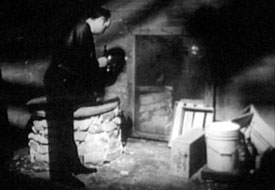 That Pickman is played by a nearly bald fool with a hysterical comb-over, more Homer Simpson than mad artist, makes it visually difficult to take seriously, though the guy does have a crazy look about him. That Pickman is played by a nearly bald fool with a hysterical comb-over, more Homer Simpson than mad artist, makes it visually difficult to take seriously, though the guy does have a crazy look about him.
Lines like "What do you moderns know of life?" could work if the acting were any good, but it comes off at best as a pre-adolescent in a bad mood.
Pickman appreciates William's supportive sentiments about macabre art (howlingly amateur art rather). The art induces Thurber to nod off momentarily & have a rather interesting nightmare. He awakens & PIckman reveals the secret that his art is "more than imagination."
Most of the weaknesses of the film could be overlooked & the cool nightmare become the focus of some praise, but for one abysmal element that spoils even the best moments. The artwork is central to the story, & this isn't the only version that just couldn't come up with art of merit, but it may win the award for artworks of least merit.
Some adaptations show no art at all, being aware that a bad stab as abject evil would be worse than no stab at all. Welch leaps right in with amateur werewolf drawings of the most idiotic sort. "The faces, they look so real," says William of a garish werewolf sketch. When Thurber acts disturbed by innocuous poor drazwings, the attempt at Lovecraftian atmosphere deflates into a kiddy show for a safe Halloween.
In Pickman's cellar is an old well, down which the titular model dwells. This well looks like a prop for the church bazare, a wishing well into which to toss coins. Or perhaps a nice home-made gardening container of stacked stones. And when we cut away to the rats in the garbage, they're albino & saddle-marked pet rats, oh so cute yes you are.
Since we've already seen the bad sketches of werewolves, we no longer expect anything interesting from the well, so there's no disappointment that the director doesn't even bother. Pickman, however, seems to be changing into a werewolf, & even Thurber has fur on his hands. It's brave to try for a climax totally different from Lovecraft's, but did nobody mention this new ending is more of a masturbation joke than a spooky moment?
The "proof" that Pickman had of an actual monster remains the photograph. And there's a "scary" final-second climax that fails oh so miserably.
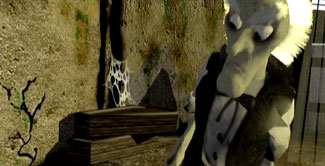 The fourth volume The H. P. Lovecraft Collection, in addition to three versions of Pickman's Model, includes two additional short subjects inspired by different Lovecraft stories. The fourth volume The H. P. Lovecraft Collection, in addition to three versions of Pickman's Model, includes two additional short subjects inspired by different Lovecraft stories.
Also among the extras are two trival non-fiction short subjects, too trivial to do more than mention in passing. One is a short-short interview with the modern horror writer Ramsey Campbell, who would've been interesting to see actually interviewed.
The other is a discussion with "BNF" (big name fan) & Lovecraftian fan-editor Robert Price, who provides a glimpse of a basic fannish type among "sercon" type fans (meaning "serious & constructive"). He must've been terrorized by the camera as I'm sure he's more personable than is conveyed. I wouldn't've included either of these "extras" as they're just too piffly. There exist other versions of Pickman's Model however & it might've been nice to track down a couple more of those.
The least of the four short films is In the Vault (2001), a 3-D computer-animated adaptaton of HPL's 1925 story of the same name.
Lovecraft had submitted this story to Farnsworth Wright, editor of Weird Tales: The Unique Magazine, & it was rejected as being too gruesome to pass Indiana's censorship, Wright having but recently had a magazine removed from racks by censors, which his magazine could ill afford.
So Lovecraft published it in an amateur magazine called Tryout. He tried the following year to get it reprinted in the pulp magazine Ghost Stories only to have it rejected again, then re-submitted it to Weird Tales when censorship of the magazine had quietened, & in 1932 it had its first professional publication therein.
It was in reality not "too gruesome" or anything of the sort. It was merely one of Lovecraft's least interesting stories, & likely Farnsworth only broke down & accepted it seven years later, to use as space-filler, because HPL had in the meantime become the magazine's setar, & even a minor effort might sell a few extra copies.
The animated version makes it more trivial still. It shows no mastery of the computer program that made this cartoon with wooden movement; the design is second by second completely amateurish as art, & devoid of eeriness.
A gravedigger (named George Birch in the short story) pisses in the graves & is in general disrespectful of the dead. He gets trapped in a vault with the as yet unburied dead. As he chisels out a narrow window, his foot goes through the lid of the coffin he's standing on, & he is bitten, or at least scratched by the wood. He's afterward transformed into an honest respectful sexton. Feh.
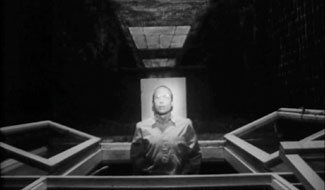 Between the Stars (1998), by Netherlands short filmmaker Djie Han Thung, is very loosely inspired by HPL's highly poetic but unfinished short story "Azathoth."
Between the Stars (1998), by Netherlands short filmmaker Djie Han Thung, is very loosely inspired by HPL's highly poetic but unfinished short story "Azathoth."
"Azathoth" is a contraction of Azazel the desert-demon of scripture, with ibis-headed Thoth the Egyptian god of astronomy & occultism & a judge of the dead). But it's only an inspiration & Between the Stars makes no reference to "the idiot-god" Azathoth.
At a scant five minute length, this is the only item on the fourth volume of The H. P. Lovecraft Collection to compete with the Italian version of Pickman's Model for interest.
As poetic as its inspiration, filmed in the moodiest of black & white. Minnekens (Jos Urbanus) is a glum office worker. He returns to his lonely dark apartment. His only window opens into an air shaft. He places a long board on the window sill & sleeps with his head outside the window, looking up the shaft at the stars.
Every day is the same. As he has no friends, he never speaks to anyone, dwelling in a mute world. The stars above the shaft are all he has.
One night he realizes he has the power to enter a cosmic realm. He reaches upward, touches the star, & rises into the cosmos.
Lovecraft's original fragment speaks of Azathoth as a creature of worship, but this adaptation does not reference any portion of the Cthulhu mythos or Azathoth cycle, so that Minnekens could be merely a lonesome man who achieves a welcome dissolution or escape from tragic reality.
Behind the closing credits we hear a brief director commentary in which he pretty much admits it doesn't mean anything. He has every right to be proud of it, though; it's a lovely little art film. (See more short films by Djie Han Thung.)
Continue to
More Adaptations of Pickman's Model
copyright © by Paghat the Ratgirl
|
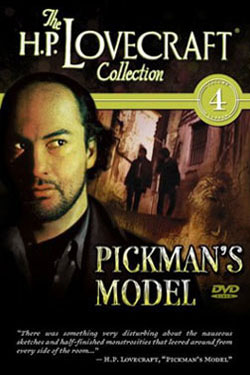
 The Italian horror short Pickman's Model (2007) was included in the "extras" of the H. P. Lovecraft Collection Volume 4 (2007).
The Italian horror short Pickman's Model (2007) was included in the "extras" of the H. P. Lovecraft Collection Volume 4 (2007). He then leaves the stone-walled studio, locking her underground. Her demise, at the hands of what unknown creature, occurs off screen, reliant as it is on mood rather than gore.
He then leaves the stone-walled studio, locking her underground. Her demise, at the hands of what unknown creature, occurs off screen, reliant as it is on mood rather than gore. After Pickman forcibly removed Marsh from the underground studio, he listens through a door. Sound alone conveys the final terrible fate of Pickman.
After Pickman forcibly removed Marsh from the underground studio, he listens through a door. Sound alone conveys the final terrible fate of Pickman. Gabriel Martinez (Rodrigo Sepulveda) has lost a friend Aǹbal (Gilberto Villarroel) under horrific circumstances. He secretly belives the responsible culprit is Richard Upton Pickman (Renzo Oviedo), an eccentric artist of occult subjects. Under cover of his actual profession as journalist, he undertakes to locate the missing artist.
Gabriel Martinez (Rodrigo Sepulveda) has lost a friend Aǹbal (Gilberto Villarroel) under horrific circumstances. He secretly belives the responsible culprit is Richard Upton Pickman (Renzo Oviedo), an eccentric artist of occult subjects. Under cover of his actual profession as journalist, he undertakes to locate the missing artist. Which is to say, the search for the man is more interesting than finding him, as Renzo Oviedo is not the best actor in the cast & his melodramatic line delivery gives it the tone of a second-rate Mexican horror tale of the 1950s, not really capturing the decadence & obsession of a mad aesthete.
Which is to say, the search for the man is more interesting than finding him, as Renzo Oviedo is not the best actor in the cast & his melodramatic line delivery gives it the tone of a second-rate Mexican horror tale of the 1950s, not really capturing the decadence & obsession of a mad aesthete. Perhaps it was meant to imply that the "well" around which Pickman has built is subterranean art studio is as Poe's Gordon Pym discovered "black as the pit from Pole to Pole."
Perhaps it was meant to imply that the "well" around which Pickman has built is subterranean art studio is as Poe's Gordon Pym discovered "black as the pit from Pole to Pole." A student thesis version of Pickman's Model (1981) is in black & white, directed by Austin's Cathy Welch. A big part of my psyche wants women to be better than guys when they make a Lovecraftian film, as women are a distinct minority in horror direction, & should bring something a little different & perhaps better.
A student thesis version of Pickman's Model (1981) is in black & white, directed by Austin's Cathy Welch. A big part of my psyche wants women to be better than guys when they make a Lovecraftian film, as women are a distinct minority in horror direction, & should bring something a little different & perhaps better. That Pickman is played by a nearly bald fool with a hysterical comb-over, more Homer Simpson than mad artist, makes it visually difficult to take seriously, though the guy does have a crazy look about him.
That Pickman is played by a nearly bald fool with a hysterical comb-over, more Homer Simpson than mad artist, makes it visually difficult to take seriously, though the guy does have a crazy look about him. The fourth volume The H. P. Lovecraft Collection, in addition to three versions of Pickman's Model, includes two additional short subjects inspired by different Lovecraft stories.
The fourth volume The H. P. Lovecraft Collection, in addition to three versions of Pickman's Model, includes two additional short subjects inspired by different Lovecraft stories. Between the Stars (1998), by Netherlands short filmmaker Djie Han Thung, is very loosely inspired by HPL's highly poetic but unfinished short story "Azathoth."
Between the Stars (1998), by Netherlands short filmmaker Djie Han Thung, is very loosely inspired by HPL's highly poetic but unfinished short story "Azathoth."